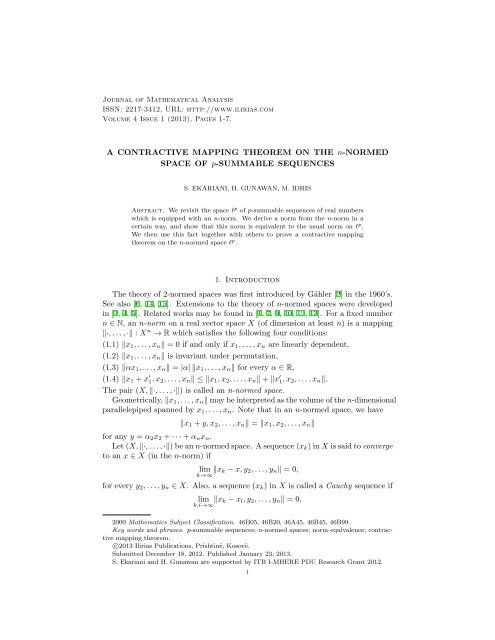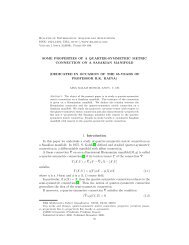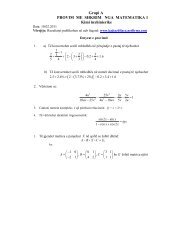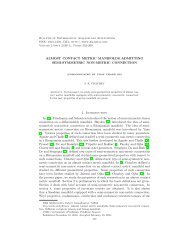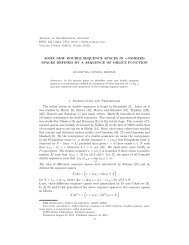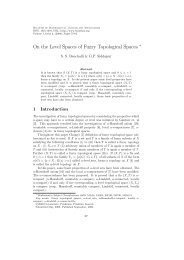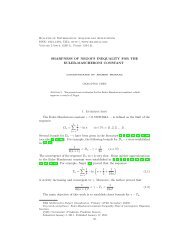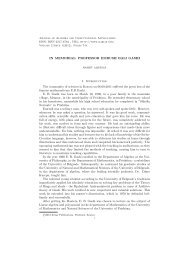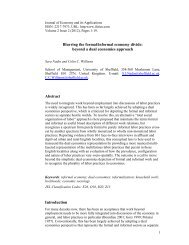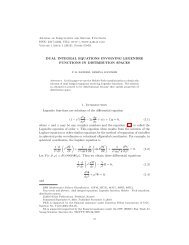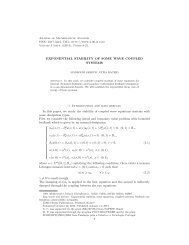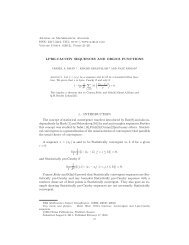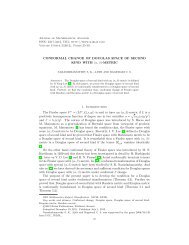NORMED SPACE OF
NORMED SPACE OF
NORMED SPACE OF
Create successful ePaper yourself
Turn your PDF publications into a flip-book with our unique Google optimized e-Paper software.
Journal of Mathematical Analysis<br />
ISSN: 2217-3412, URL: http://www.ilirias.com<br />
Volume 4 Issue 1 (2013), Pages 1-7.<br />
A CONTRACTIVE MAPPING THEOREM ON THE n-<strong>NORMED</strong><br />
<strong>SPACE</strong> <strong>OF</strong> p-SUMMABLE SEQUENCES<br />
S. EKARIANI, H. GUNAWAN, M. IDRIS<br />
Abstract. We revisit the space l p of p-summable sequences of real numbers<br />
which is equipped with an n-norm. We derive a norm from the n-norm in a<br />
certain way, and show that this norm is equivalent to the usual norm on l p .<br />
We then use this fact together with others to prove a contractive mapping<br />
theorem on the n-normed space l p .<br />
1. Introduction<br />
The theory of 2-normed spaces was first introduced by Gähler [2] in the 1960’s.<br />
See also [6, 14, 15]. Extensions to the theory of n-normed spaces were developed<br />
in [3, 4, 5]. Related works may be found in [1, 7, 9, 10, 12, 13]. For a fixed number<br />
n ∈ N, an n-norm on a real vector space X (of dimension at least n) is a mapping<br />
∥⋅, . . . , ⋅∥ : X n → R which satisfies the following four conditions:<br />
(1.1) ∥x 1 , . . . , x n ∥ = 0 if and only if x 1 , . . . , x n are linearly dependent,<br />
(1.2) ∥x 1 , . . . , x n ∥ is invariant under permutation,<br />
(1.3) ∥αx 1 , . . . , x n ∥ = ∣α∣ ∥x 1 , . . . , x n ∥ for every α ∈ R,<br />
(1.4) ∥x 1 + x ′ 1, x 2 , . . . , x n ∥ ≤ ∥x 1 , x 2 , . . . , x n ∥ + ∥x ′ 1, x 2 , . . . , x n ∥.<br />
The pair (X, ∥⋅, . . . , ⋅∥) is called an n-normed space.<br />
Geometrically, ∥x 1 , . . . , x n ∥ may be interpreted as the volume of the n-dimensional<br />
parallelepiped spanned by x 1 , . . . , x n . Note that in an n-normed space, we have<br />
∥x 1 + y, x 2 , . . . , x n ∥ = ∥x 1 , x 2 , . . . , x n ∥<br />
for any y = α 2 x 2 + ⋅ ⋅ ⋅ + α n x n .<br />
Let (X, ∥⋅, . . . , ⋅∥) be an n-normed space. A sequence (x k ) in X is said to converge<br />
to an x ∈ X (in the n-norm) if<br />
lim ∥x k − x, y 2 , . . . , y n ∥ = 0,<br />
k→∞<br />
for every y 2 , . . . , y n ∈ X. Also, a sequence (x k ) in X is called a Cauchy sequence if<br />
lim ∥x k − x l , y 2 , . . . , y n ∥ = 0,<br />
k,l→∞<br />
2000 Mathematics Subject Classification. 46B05, 46B20, 46A45, 46B45, 46B99.<br />
Key words and phrases. p-summable sequences; n-normed spaces; norm equivalence; contractive<br />
mapping theorem.<br />
c⃝2013 Ilirias Publications, Prishtinë, Kosovë.<br />
Submitted December 18, 2012. Published January 23, 2013.<br />
S. Ekariani and H. Gunawan are supported by ITB I-MHERE PDU Research Grant 2012.<br />
1
2 S. EKARIANI, H. GUNAWAN, M. IDRIS<br />
for every y 2 , . . . , y n ∈ X.<br />
If every Cauchy sequence (x k ) in X converges to some x ∈ X, then X is said to<br />
be complete. A complete n-normed space is called an n-Banach Space.<br />
Our interest here is in the existence of a fixed point of a contractive mapping<br />
on an n-Banach space. In particular, we shall consider the space l p of p-summable<br />
sequences of real numbers, where 1 ≤ p ≤ ∞, that is, the space of all sequences<br />
x = (ξ j ) for which ∑ ∣ξ j ∣ p < ∞ when 1 ≤ p < ∞ (or sup ∣ξ j ∣ < ∞ when p = ∞).<br />
j<br />
j<br />
For 1 ≤ p < ∞, we equip l p with the following n-norm (for a fixed number n ∈ N)<br />
⎡<br />
⎤ 1<br />
∥x 1 , . . . , x n ∥ p := ⎣ 1 ∑<br />
⋅ ⋅ ⋅ ∑ p<br />
∣ ∣ ∣∣det ∣∣<br />
p<br />
[ξijk ] ⎦<br />
n!<br />
i,k<br />
,<br />
j 1 j n<br />
where x i := (ξ ij ) ∈ l p , i = 1, . . . , n. For p = ∞, the n-norm is given by<br />
∣ ∣ ∣∣det ∣∣<br />
∥x 1 , . . . , x n ∥ ∞ := sup ⋅ ⋅ ⋅ sup [ξijk ] i,k .<br />
j 1 j n<br />
The n-normed space (l p , ∥⋅, . . . , ⋅∥ p ) was first studied by Gunawan [8].<br />
In [8], Gunawan formulated a contractive mapping theorem for (l p , ∥⋅, . . . , ⋅∥ p )<br />
as follows:<br />
Theorem 1.1. [8] Let T be a self-mapping of l p which is contractive in the sense<br />
that there exists a constant C ∈ (0, 1) such that the inequality<br />
∥T x − T x ′ , y 2 , . . . , y n ∥ p ≤ C ∥x − x ′ , y 2 , . . . , y n ∥ p<br />
holds for all x, x ′ , y 2 , . . . , y n ∈ l p . Then T has a unique fixed point, that is, there<br />
exists a unique x ∈ l p such that T x = x.<br />
We notice that the hypothesis on T in the above theorem is quite strong. The<br />
aim of this note is to prove a similar theorem but with a much weaker condition.<br />
Additional results will also be presented.<br />
2. Main Results<br />
Our main result is the following theorem, which is more general than the previous<br />
theorem of Gunawan.<br />
Theorem 2.1. Let T be a self-mapping of l p which is contractive with respect to a<br />
linearly independent set {a 1 , . . . , a n } in l p , that is, there exists a constant C ∈ (0, 1)<br />
such that<br />
∥T x − T x ′ , a i2 , . . . , a in ∥ p ≤ C ∥x − x ′ , a i2 , . . . , a in ∥ p<br />
holds for all x, x ′ ∈ l p and {i 2 , . . . , i n } ⊂ {1, . . . , n}. Then T has a unique fixed<br />
point, that is, there exists a unique x ∈ l p such that T x = x.<br />
To prove the above theorem, we need several lemmas and propositions. The first<br />
lemma below from [8] gives a relationship between the n-norm ∥⋅, . . . , ⋅∥ p and the<br />
usual norm ∥ ⋅ ∥ p on l p . From now on, we assume that 1 ≤ p < ∞, and leave the<br />
case where p = ∞ to the reader.<br />
Lemma 2.2. [8] The inequality<br />
holds for every x 1 , ⋅ ⋅ ⋅ , x n ∈ l p .<br />
∥x 1 , ⋅ ⋅ ⋅ , x n ∥ p ≤ (n!) 1−(1/p) ∥x 1 ∥ p ⋅ ⋅ ⋅ ∥x n ∥ p
ON THE n-<strong>NORMED</strong> <strong>SPACE</strong> <strong>OF</strong> p-SUMMABLE SEQUENCES 3<br />
On an n-normed space, we can derive a norm from the n-norm in a certain way.<br />
In particular, on the space l p of p-summable sequences, we have the following result.<br />
Proposition 2.3. Let {a 1 , . . . , a n } be a linearly independent set on l p . Then, the<br />
following function<br />
⎡<br />
∑<br />
∥x∥ ∗ p := ⎣<br />
{i 2,...,i n}⊂{1,...,n}<br />
⎤<br />
∥x, a i2 , . . . , a in ∥ p ⎦<br />
p<br />
1<br />
p<br />
defines a norm on l p .<br />
Proof. One may verify that ∥x∥ ∗ p satisfies the four properties of a norm. In<br />
particular, we may check that if ∥x∥ ∗ p = 0, then ∥x, a i2 , . . . , a in ∥ p = 0 for every<br />
{i 2 , . . . , i n } ⊂ {1, . . . , n}. This means that x is in the linear span of {a i2 , . . . , a in }<br />
for every {i 2 , . . . , i n } ⊂ {1, . . . , n}. This forces us to conclude that x = 0. Furthermore,<br />
one may check that the triangle inequality for ∥ ⋅ ∥ ∗ p follows immediately from<br />
the triangle inequality for the n-norm and the Minkowski’s inequality for sums. □<br />
The next lemma is required to show that the norm ∥ ⋅ ∥ ∗ p is actually equivalent<br />
to the usual norm ∥ ⋅ ∥ p on l p .<br />
Lemma 2.4. For every x, y 1 , . . . , y n ∈ l p , we have<br />
∥x∥ p ∥y 1 , . . . , y n ∥ p ≤ n∥y 1 ∥ p ∥x, y 2 , y 3 , . . . , y n ∥ p +<br />
+ ∥y 2 ∥ p ∥x, y 1 , y 3 , . . . , y n ∥ p + ⋅ ⋅ ⋅ + ∥y n ∥ p ∥x, y 1 , y 2 , . . . , y n−1 ∥ p .<br />
Proof. The case n = 2 has been proved in [11]. Here we shall only give the proof<br />
for n = 3, leaving the proof for n > 3 to the reader. Let x := (ξ j ) ∈ l p and<br />
y i := (η ij ) ∈ l p , i = 1, 2, 3. We observe that<br />
∣ ∣ ∣∣ ∥x∥ p p ∥y 1 , y 2 , y 3 ∥ p p = 1 ∑ ∑ ∑ ∑ ∣∣∣∣∣ ∣∣∣∣∣ η 1j1 η 1j2 η 1j3 ∣∣∣∣∣ ∣∣∣∣∣<br />
p<br />
ξ k η 2j1 η 2j2 η 2j3 .<br />
3!<br />
k j 1 j 2 j 3 η 3j1 η 3j2 η 3j3
4 S. EKARIANI, H. GUNAWAN, M. IDRIS<br />
By Minkowski’s inequality, we have<br />
Hence we obtain<br />
⎛<br />
∣ ∣<br />
⎝ 1 ∑ ∑ ∑ ∑ ∣∣∣∣∣ ∣∣∣∣∣ η 1j1 η 1j2 η 1j3<br />
ξ k η 2j1 η 2j2 η 2j3<br />
3!<br />
k j 1 j 2 j 3 η 3j1 η 3j2 η 3j3<br />
∣∣ ∣∣∣∣∣ ∣∣∣∣∣ p⎞<br />
⎠<br />
⎛<br />
∣ ∣<br />
≤ ⎝ 1 ∑ ∑ ∑ ∑ ∣∣∣∣∣ ∣∣∣∣∣ η 2j2 η 2k η 2j3<br />
η 1j1 ξ j2 ξ k ξ j3<br />
3!<br />
k j 1 j 2 j 3 η 3j2 η 3k η 3j3<br />
∣∣ ∣∣∣∣∣ ∣∣∣∣∣ p⎞<br />
⎠<br />
⎛<br />
∣ ∣<br />
⎝ 1 ∑ ∑ ∑ ∑ ∣∣∣∣∣ ∣∣∣∣∣ η 2j1 η 2k η 2j3<br />
η 1j2 η 3j1 η 3k η 3j3<br />
3!<br />
k j 1 j 2 j 3 ξ j1 ξ k ξ j3<br />
∣∣ ∣∣∣∣∣ ∣∣∣∣∣ p⎞<br />
⎠<br />
⎛<br />
∣ ∣<br />
⎝ 1 ∑ ∑ ∑ ∑ ∣∣∣∣∣ ∣∣∣∣∣ η 2j1 η 2k η 2j2<br />
η 1j3 ξ j1 ξ k ξ j2<br />
3!<br />
k j 1 j 2 j 3 η 3j1 η 3k η 3j2<br />
∣∣ ∣∣∣∣∣ ∣∣∣∣∣ p⎞<br />
⎠<br />
⎛<br />
∣ ∣<br />
⎝ 1 ∑ ∑ ∑ ∑ ∣∣∣∣∣ ∣∣∣∣∣ η 1j1 η 1j3 η 1j2<br />
η 2k η 3j1 η 3j3 η 3j2<br />
3!<br />
k j 1 j 2 j 3 ξ j1 ξ j3 ξ j2<br />
∣∣ ∣∣∣∣∣ ∣∣∣∣∣ p⎞<br />
⎠<br />
⎛<br />
∣ ∣ ∣∣∣∣∣ ∣∣∣∣∣<br />
⎝ 1 ∑ ∑ ∑ ∑ η 1j1 η 1j3 η 1j2<br />
η 3k ξ j1 ξ j3 ξ j2<br />
3!<br />
k j 1 j 2 j 3 η 2j1 η 2j3 η 2j2<br />
∣∣ ∣∣∣∣∣ ∣∣∣∣∣ p⎞<br />
⎠<br />
= 3 ∥y 1 ∥ p ∥x, y 2 , y 3 ∥ p + ∥y 2 ∥ p ∥x, y 1 , y 3 ∥ p + ∥y 3 ∥ p ∥x, y 1 , y 2 ∥ p .<br />
∥x∥ p ∥y 1 , y 2 , y 3 ∥ p ≤ 3∥y 1 ∥ p ∥x, y 2 , y 3 ∥ p + ∥y 2 ∥ p ∥x, y 1 , y 3 ∥ p + ∥y 3 ∥ p ∥x, y 1 , y 2 ∥ p ,<br />
1<br />
p<br />
1<br />
p<br />
1<br />
p<br />
1<br />
p<br />
1<br />
p<br />
1<br />
p<br />
+<br />
+<br />
+<br />
+<br />
as desired.<br />
□<br />
Proposition 2.5. Let {a 1 , . . . , a n } be a linearly independent set on l p . Then the<br />
norm ∥ ⋅ ∥ ∗ p defined in Proposotion 2.3 is equivalent to the usual norm ∥ ⋅ ∥ p on l p .<br />
Precisely, we have<br />
n∥a 1 , . . . , a n ∥ p<br />
(2n − 1) [∥a 1 ∥ p + ⋅ ⋅ ⋅ + ∥a n ∥ p ] ∥x∥ p ≤ ∥x∥ ∗ p<br />
for every x ∈ l p .<br />
⎡<br />
≤ (n!) 1− 1 p ⎣<br />
∑<br />
{i 2,...,i n}⊂{1,...,n}<br />
⎤<br />
∥a i2 ∥ p p ⋅ ⋅ ⋅ ∥a in ∥ p ⎦<br />
p<br />
1<br />
p<br />
∥x∥ p<br />
Proof. For any x ∈ l p and any subset {i 2 , . . . , i n } of {1, 2, . . . , n}, we observe that<br />
∥x, a i2 , . . . , a in ∥ p ≤ (n!) 1−(1/p) ∥x∥ p ∥a i2 ∥ p ⋅ ⋅ ⋅ ∥a in ∥ p .
ON THE n-<strong>NORMED</strong> <strong>SPACE</strong> <strong>OF</strong> p-SUMMABLE SEQUENCES 5<br />
Hence<br />
∥x∥ ∗ p =<br />
≤<br />
⎡<br />
∑<br />
⎣<br />
{i 2,...,i n}⊂{1,...,n}<br />
⎡<br />
(n!) 1− 1 p ⎣<br />
⎤<br />
∥x, a i2 , . . . , a in ∥ p ⎦<br />
p<br />
∑<br />
{i 2,...,i n}⊂{1,...,n}<br />
1<br />
p<br />
⎤<br />
1<br />
p<br />
∥a i2 ∥ p p ⋅ ⋅ ⋅ ∥a in ∥ p ⎦<br />
p ∥x∥ p .<br />
By the inequality in Lemma 2.4, we have<br />
∥x∥ p ∥a 1 , a 2 , . . . , a n ∥ p ≤ n∥a 1 ∥ p ∥x, a 2 , a 3 , . . . , a n ∥ p +<br />
+ ∥a 2 ∥ p ∥x, a 1 , a 3 , . . . , a n ∥ p +<br />
⋅ ⋅ ⋅ + ∥a n ∥ p ∥x, a 1 , a 2 , . . . , a n−1 ∥ p<br />
∥x∥ p ∥a 2 , a 1 , . . . , a n ∥ p ≤ n∥a 2 ∥ p ∥x, a 1 , a 3 , . . . , a n ∥ p +<br />
+ ∥a 1 ∥ p ∥x, a 2 , a 3 , . . . , a n ∥ p +<br />
⋅ ⋅ ⋅ + ∥a n ∥ p ∥x, a 1 , a 2 , . . . , a n−1 ∥ p<br />
.<br />
∥x∥ p ∥a n , a 1 , . . . , a n−1 ∥ p ≤ n∥a n ∥ p ∥x, a 1 , a 2 , . . . , a n−1 ∥ p +<br />
+ ∥a 1 ∥ p ∥x, a n , a 2 , . . . , a n−1 ∥ p +<br />
⋅ ⋅ ⋅ + ∥a n−1 ∥ p ∥x, a n , a 1 , . . . , a n−2 ∥ p ,<br />
whence<br />
n∥x∥ p ∥a 1 , a 2 , . . . , a n ∥ p ≤ (2n − 1)∥a 1 ∥ p ∥x, a 2 , a 3 , . . . , a n ∥ p +<br />
⋅ ⋅ ⋅ + (2n − 1)∥a n ∥ p ∥x, a 1 , a 2 , . . . , a n−1 ∥ p .<br />
Next, we observe that<br />
⎡<br />
⎤ 1<br />
p<br />
∑<br />
∥x, a 2 , a 3 , . . . , a n ∥ p ≤ ⎣<br />
∥x, a i2 , . . . , a in ∥ p ⎦<br />
p = ∥x∥ ∗ p<br />
{i 2,...,i n}⊂{1,...,n}<br />
.<br />
∥x, a 1 , a 2 , . . . , a n−1 ∥ p ≤<br />
Hence, we obtain<br />
⎡<br />
∑<br />
⎣<br />
{i 2,...,i n}⊂{1,...,n}<br />
⎤<br />
1<br />
p<br />
∥x, a i2 , . . . , a in ∥ p ⎦<br />
p = ∥x∥ ∗ p.<br />
n∥x∥ p ∥a 1 , a 2 , . . . , a n ∥ p ≤ (2n − 1) [∥a 1 ∥ p + ⋅ ⋅ ⋅ + ∥a n ∥ p ] ∥x∥ ∗ p.<br />
This completes the proof.<br />
Since (l p , ∥ ⋅ ∥ p ) is a Banach space, we have the following corollary.<br />
□<br />
Corollary 2.6. The normed space (l p , ∥ ⋅ ∥ ∗ p) is a Banach space.
6 S. EKARIANI, H. GUNAWAN, M. IDRIS<br />
Now we come to the proof of our main theorem, namely Theorem 2.1. All the<br />
previous results make the proof very simple.<br />
Proof of Theorem 2.1. For any x, x ′ ∈ l p , we observe that<br />
∥T x − T x ′ ∥ ∗ p =<br />
⎡<br />
⎣<br />
∑<br />
⎤<br />
∥T x − T x ′ , a i2 , . . . , a in ∥ p ⎦<br />
p<br />
≤<br />
⎡<br />
⎣<br />
= C ⎣<br />
{i 2,...,i n}⊂{1,...,n}<br />
∑<br />
{i 2,...,i n}⊂{1,...,n}<br />
⎡<br />
∑<br />
{i 2,...,i n}⊂{1,...,n}<br />
= C ∥x − x ′ ∥ ∗ p.<br />
⎤<br />
C p ∥x − x ′ , a i2 , . . . , a in ∥ p ⎦<br />
p<br />
⎤<br />
∥x − x ′ , a i2 , . . . , a in ∥ p ⎦<br />
p<br />
This shows that T is a contractive mapping with respect to ∥⋅∥ ∗ p. Since (l p , ∥⋅∥ ∗ p) is<br />
a Banach space, by the contractive mapping theorem for Banach spaces we conclude<br />
that T has a unique fixed point in l p .<br />
□<br />
3. Further Results<br />
By Lemma 2.2, we see that, in l p , if a sequence (x k ) converges to x in the usual<br />
norm ∥ ⋅ ∥ p , then it also converges to x in the n-norm ∥⋅, . . . , ⋅∥ p . Similarly, if (x k )<br />
is a Cauchy sequence with respect to ∥ ⋅ ∥ p , then it is also a Cauchy sequence with<br />
respect to ∥⋅, . . . , ⋅∥ p .<br />
Now, as a consequence of Proposition 2.5, we have the following theorem.<br />
Theorem 3.1. A sequence (x k ) ∈ l p converges to an x ∈ l p in ∥⋅, . . . , ⋅∥ p if and<br />
only if (x k ) converges to x in ∥ ⋅ ∥ p . Similarly, (x k ) ∈ l p is a Cauchy sequence with<br />
respect to ∥⋅, . . . , ⋅∥ p if and only if (x k ) is a Cauchy sequence with respect to ∥ ⋅ ∥ p .<br />
Proof. Let (x k ) ∈ l p converge to an x ∈ l p in ∥ ⋅ ∥ p , that is, lim<br />
k→∞ ∥x k − x∥ p = 0.<br />
Hence, for every y 2 , . . . , y n ∈ l p , we have (by Lemma 2.2)<br />
lim ∥x k − x, y 2 , . . . , y n ∥ p ≤ lim<br />
k→∞ k→∞ (n!)1−(1/p) ∥x k − x∥ p ∥y 2 ∥ p ⋅ ⋅ ⋅ ∥y n ∥ p = 0.<br />
This tells us that (x k ) converges to x in ∥⋅, . . . , ⋅∥ p .<br />
Conversely, let (x k ) ∈ l p converge to x ∈ l p in ∥⋅, . . . , ⋅∥ p , that is,<br />
lim ∥x k − x, y 2 , . . . , y n ∥ p = 0,<br />
k→∞<br />
for every y 2 , . . . , y n ∈ l p . Let {a 1 , . . . , a n } be a linearly independent set on l p and<br />
∥ ⋅ ∥ ∗ p be defined as in Proposition 2.3. Then, for any {i 2 , . . . , i n } ⊂ {1, . . . , n}, we<br />
have<br />
lim ∥x k − x, a i2 , . . . , a in ∥ p = 0,<br />
k→∞<br />
so that lim ∥x k −x∥ ∗ p = 0. It follows from Proposition 2.5 that lim ∥x k −x∥ p = 0,<br />
k→∞ k→∞<br />
which means that (x k ) converges to x in ∥ ⋅ ∥ p .<br />
The proof of the second part is similar, and so we are done.<br />
□<br />
Corollary 3.2. The n-normed space (l p , ∥⋅, . . . , ⋅∥ p ) is an n-Banach space.<br />
1/p<br />
1/p<br />
1/p
ON THE n-<strong>NORMED</strong> <strong>SPACE</strong> <strong>OF</strong> p-SUMMABLE SEQUENCES 7<br />
Acknowledgments. The authors would like to thank the anonymous referee for<br />
his/her comments that helped us improve this paper.<br />
References<br />
[1] C. Diminnie, S. Gähler and A. White, 2-inner product spaces, Demonstratio Math. 6 (1973),<br />
525–536.<br />
[2] S. Gähler, Lineare 2-normierte räume, Math. Nachr. 28 (1964), 1–43.<br />
[3] S. Gähler, Untersuchungen über verallgemeinerte m-metrische Räume. I, Math. Nachr. 40<br />
(1969), 165 - 189.<br />
[4] S. Gähler, Untersuchungen über verallgemeinerte m-metrische Räume. II, Math. Nachr. 40<br />
(1969), 229–264.<br />
[5] S. Gähler, Untersuchungen über verallgemeinerte m-metrische Räume. III, Math. Nachr. 41<br />
(1969), 23–36.<br />
[6] S. Gähler, Uber 2-Banach räume, Math. Nachr. 42 (1969), 335–347.<br />
[7] S. Gähler, A.H. Siddiqi and S.C. Gupta, Contributions to non-Archimedean functional analysis,<br />
Math. Nachr. 69 (1975), 163–171.<br />
[8] H. Gunawan, The space of p-summable sequences and its natural n-norms, Bull. Austral.<br />
Math. Soc. 64 (2001), 137–147.<br />
[9] H. Gunawan, On n-inner products, n-norms, and the Cauchy-Schwarz inequality, Sci. Math.<br />
Jpn. 55 (2002), 53–60.<br />
[10] H. Gunawan and Mashadi, On n-normed spaces, Int. J. Math. Math. Sci. 27 (2001), 631–639.<br />
[11] M. Idris, S. Ekariani and H. Gunawan, On the space of p-summable sequences, Mat. Vesnik.<br />
63 (2013), 58–63.<br />
[12] A. Malčeski, l ∞ as n-normed space, Mat. Bilten 21 (1997), 103–110.<br />
[13] A. Misiak, n-inner product spaces, Math. Nachr. 140 (1989), 299–319.<br />
[14] A.H. Siddiqi, 2-normed spaces, Aligarh Bull. Math. 7 (1977), 53–70.<br />
[15] A.G. White, 2-Banach spaces, Math. Nachr. 42 (1969), 43–60.<br />
Shelvi Ekariani<br />
Department of Mathematics, Bandung Institute of Technology, Bandung 40132, Indonesia<br />
E-mail address: shelvi ekariani@students.itb.ac.id.<br />
Hendra Gunawan<br />
Department of Mathematics, Bandung Institute of Technology, Bandung 40132, Indonesia<br />
E-mail address: hgunawan@math.itb.ac.id<br />
Mochammad Idris<br />
Department of Mathematics, Universitas Lambung Mangkurat, Banjarbaru, Indonesia<br />
E-mail address: awmius@yahoo.com.


